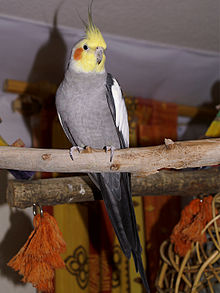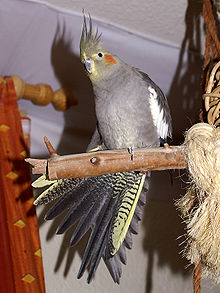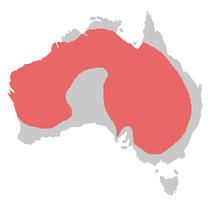
Cockatiel
Background to the schools Wikipedia
The articles in this Schools selection have been arranged by curriculum topic thanks to SOS Children volunteers. Sponsor a child to make a real difference.
| Cockatiel | |
|---|---|
 |
|
| Male | |
 |
|
| Female | |
| Conservation status | |
 Least Concern ( IUCN 3.1) |
|
| Scientific classification | |
| Kingdom: | Animalia |
| Phylum: | Chordata |
| Class: | Aves |
| Order: | Psittaciformes |
| Superfamily: | Cacatuoidea |
| Family: | Cacatuidae |
| Subfamily: | Nymphicinae |
| Genus: | Nymphicus Wagler, 1832 |
| Species: | N. hollandicus |
| Binomial name | |
| Nymphicus hollandicus ( Kerr, 1792) |
|
 |
|
| Cockatiel range (in red; all-year resident) | |
| Synonyms | |
|
Psittacus hollandicus Kerr, 1792 |
|
The Cockatiel (Nymphicus hollandicus), also known as the Quarrion and the Weiro, is a member of the cockatoo family endemic to Australia. They are prized as a household pet and companion parrot throughout the world and are relatively easy to breed. As a caged bird, cockatiels are second in popularity only to the Budgerigar.
The cockatiel is the only member of the genus Nymphicus. It was previously considered a crested parrot or small cockatoo; however, more recent molecular studies have assigned it to its own unique Cockatoo subfamily Nymphicinae. It is, therefore, now classified as the smallest of the Cacatuidae (Cockatoo family). Cockatiels are native to Australia, and favour the Australian wetlands, scrublands, and bush lands.
Taxonomy and etymology
Originally described by Scottish writer and naturalist Robert Kerr in 1793 as Psittacus hollandicus, the Cockatiel (or cockateel) was moved to its own genus, Nymphicus, by Wagler in 1832. Its genus name reflects the experience of one of the earliest groups of Europeans to see the birds in their native habitat; the travelers thought the birds were so beautiful that they named them after mythical nymphs. The specific name hollandicus refers to New Holland, a historic name for Australia.
Its biological relationship had long been argued; it is now classified into a monotypic subfamily Nymphicinae but had sometimes in the past been misclassified among the Platycercinae, the broad-tailed Parakeets. This issue has now been settled with molecular studies. A 1984 study of protein allozymes signalled its closer relationship to cockatoos than to parrots, and Mitochondrial 12S rRNA sequence data places it amongst the Calyptorhynchinae (Dark Cockatoos) subfamily. The unique, Parakeet (meaning LONG-tailed Parrot) morphological feature is a consequence of the decrease in size and accompanying change of ecological niche.
Sequence analysis of intron 7 of the nuclear ?- fibrinogen gene, on the other hand, indicates that it may yet be distinct enough as to warrant recognition of the Nymphicinae rather than inclusion of the genus in the Calyptorhynchinae.
The Cockatiel is now biologically classified as a genuine member of Cacatuidae on account of sharing all of the Cockatoo family's biological features, namely, the erectile crest, a gallbladder, powder down, suppressed cloudy-layer (enabling Lories, Lorikeets (long-tailed Lories), Parakeets and typical Parrot species' display of structural colours such as aquas, blues, greens, purples and turquoises), and facial feathers covering the sides of the beak, all of which are rarely found outside the Cacatuidae family.
Sexual dimorphism
All wild cockatiel (also known as the Normal Grey Cockatiel) chicks and juveniles are phenotypically female, and virtually indistinguishable from the time of hatching until their first molting. They display horizontal yellow stripes or bars on the ventral surface of their tail feathers, yellow spots on the ventral surface of the primary flight feathers of their wings, a gray colored crest and face, and a dull orange patch on each of their cheeks.
Adult cockatiels are sexually dimorphic, though to a lesser degree than many other avian species. This is only evident after the first molting, typically occurring about six to nine months after hatching: the male loses the white or yellow barring and spots on the underside of his tail feathers and wings. The gray feathers on his cheeks and crest are replaced by bright yellow feathers, while the orange cheek patch becomes brighter and more distinct. The face and crest of the female will typically remain mostly gray, though also with an orange cheek patch. Additionally, the female commonly retains the horizontal barring on the underside of her tail feathers.
The colour in cockatiels is derived from two pigments: Melanin (which provides the gray colour in the feathers, eyes, beak, and feet), and lipochromes (which provide the yellow color on the face and tail and the orange color of the cheek patch). The gray colour of the melanin overrides the yellow and orange of the lipochromes when both are present.
The melanin content decreases in the face of the males as they mature, allowing the yellow and orange lipochromes to be more visible, while an increase in melanin content in the tail causes the disappearance of the horizontal yellow tail bars.
In addition to these visible characteristics, the vocalization of adult males is typically louder and more complex than that of females.
Portrayal
The Cockatiel's distinctive erectile crest expresses the animal's state of being. The crest is dramatically vertical when the cockatiel is startled or excited, gently oblique in its neutral or relaxed state, and flattened close to the head when the animal is angry or defensive. The crest is also held flat but protrudes outward in the back when the cockatiel is trying to appear alluring or flirtatious. In contrast to most Cockatoos, the Cockatiel has long tail feathers roughly making up half of its total length. At 30 cm to 33 cm (12 to 13 ins), the Cockatiel is the smallest of the Cockatoos. The latter ranging between 30 cm to 60 cm (12–24 in) in length.
The "Normal Grey" or "Wild-type" cockatiel's plumage is primarily grey with prominent white flashes on the outer edges of each wing. The face of the male is yellow or white, while the face of the female is primarily grey or light grey, and both sexes feature a round orange area on both ear areas, often referred to as "cheddar cheeks." This orange colouration is generally vibrant in adult males, and often quite muted in females. Visual sexing is often possible with this variant of the bird.
Distribution and habitat
 |
Cockatiel calling
Recording of a cockatiel.
|
| Problems listening to this file? See media help. | |
Cockatiels are native to Australia, where they are found largely in arid or semi-arid country, but always close to water. Largely nomadic, the species will move to where food and water is available. They are typically seen in pairs or small flocks. Sometimes, hundreds will flock around a single such body of water. To many farmers' dismay, they often eat cultivated crops. They are absent from the most fertile southwest and southeast corners of the country, the deepest Western Australian deserts, and Cape York Peninsula. They are the only Cockatoo species which can sometimes reproduce in the end of their first year.
Life span
The Cockatiel's lifespan in captivity is generally given as 15–20 years, though it is sometimes given as short as 10–15 years, and there are reports of Cockatiels living as long as 32 years, the oldest confirmed specimen reported being 36 years old. Diet and exercise are major determining factors in cockatiel lifespan.
Colour mutations
Fifteen different Cockatiel colour mutations are currently established in aviculture, including Grey, Pied, Pearled, Cinnamon, Whitefaced, Lutino, Albino (aka. Whitefaced Lutino) and Yellowcheeked Cockatiels. Mutations in captivity have emerged in various colors, some quite different from those observed in nature. In 1949 the species began to spread throughout the world, with the creation of "wild," and then "pied" mutation developed in California in the United States. There are many mutations of Cockatiels with varied colors, they are: silvestre, harlequin, lutino, cinnamon, opaline (pearl), cara black, silver, fawn, albino (there is a pattern and not just albino genetic mutations), pastel, silver and recessive silver dominant.

